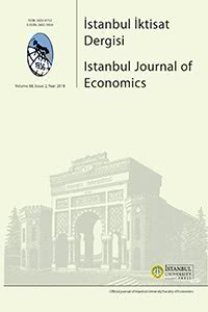HİBRİT İŞ ÖZELLİKLERİ ÇERÇEVESİNDE MAVİ YAKALI ÇALIŞANLARIN İŞ MOTİVASYONU VE İSRAFIN ÖNLENEREK KAYNAKLARIN VERİMLİ KULLANILMASI
Araştırmada hibrit iş özellikleri kuramı çerçevesinde “stres” ile “bağlılık” olgusu birleştirilerek işçi, operatör, mavi yakalı ve yan sanayi çalışanlarının motivasyonunu ölçmek amacı ile Türkiye’de en iyi üretim pratiklerine sahip işletmelerde rastgele seçilmiş 479 kişi ile anket çalışması yapılmış ve “yan sanayi çalışanı olması”, “iş tanım farklılıkları” ve “çalışma yılı” ile “motivasyon” arasında önemli bir ilişki bulunmuştur. Bakım-onarım, üretim, kalite-depo çalışanlarının sırasıyla motivasyon derecelerinin azaldığı, hibrit iş özellikleri kuramı ve diğer değişkenler ile motivasyon arasında güçlü bir ilişki saptanmıştır. Çalışma sonuçlarıyla algoritma denemesi yapılmış, öz yeterlik, özerklik, geribildirim, bağlılık ve streste anket sonuçlarına göre motivasyon derecesi hesaplanarak en yüksek dereceye bakılmıştır. Farklı hesaplama yöntemlerinde motivasyon derecesi 0.78’den (en yüksek: 1.00) aşağı düşmemiştir. Stresin motivasyonu azaltıcı etki yaptığını göz ardı etmemek gerektiği ortaya çıkmıştır. Çalışmada hibrit iş özellikleri kuramı ve ona etki eden değişkenlerin mavi yakalıların motivasyonuna etkisinin oldukça yüksek olduğu saptanmıştır. Motivasyon olgusunun “vererek” değil, “üreterek” de olabilirliği sınanmış ve rekabette üstünlük, işte verimlilik ve hayatta mutluluk için motivasyon kaynağının günlük aktiviteler olduğu görülmüştür. Motivasyon artışının sonucu olarak çalışanların çalışma verimini arttırarak kaynakların verimli kullanılması sağlanmıştır.
Anahtar Kelimeler:
hibrit iş özellikleri, stres, örgütsel bağlılık, motivasyon, öz yeterlik, özerklik, geribildirim, yalın üretim, mavi yakalı çalışan, Verimlilik
HİBRİT İŞ ÖZELLİKLERİ ÇERÇEVESİNDE MAVİ YAKALI ÇALIŞANLARIN İŞ MOTİVASYONU VE İSRAFIN ÖNLENEREK KAYNAKLARIN VERİMLİ KULLANILMASI
This study combines stress and relatedness within the framework of hybrid job characteristics theory to measure the motivation of laborers, operators, blue collar and ancillary workers. Results of survey with randomly selected 479 people in leading industrial corporations in Turkey showed a strong correlation between the workers’ motivation and being an ancillary industry worker, differences in job description and years of work. Findings showed a decreasing motivation in maintenance, repair, production and quality-store workers, respectively; a strong link between motivation and hybrid job characteristics theory with other variables. An algorithm experiment was conducted with obtained results. The motivation degree was calculated with the results of survey on self-efficacy, autonomy, feedback, relatedness and stress, and the highest degree was analyzed. Different calculation methods showed the degree of motivation as 0.78 (max. 1.00). Study reveals the need not to disregard the mitigating impact of stress.The impact of hybrid job characteristics theory and other variables on the motivation of blue-collar workers was found to be quite high. The possibility of motivation by “producing”, rather than “giving” was tested and simple daily activities were found to be the source of motivation for successful competition, productive work and happy life.
Keywords:
hybrid job specifications, stress, relatedness, motivation, self- efficacy, autonomy, feedback, lean manufacturing, blue collar workers,
___
- AŞAN, Ö.: (2001), “Motivasyon”, Yönetim ve Organizasyon, (Ed. Salih Güney), Nobel Yayınları, Ankara, 247, 225-255, http://dergi.sayistay.gov.tr/icerik/der88m5.pdf, 21 Ocak 2015).
- BANDURA, A.: (1977), “Self-Efficacy: Toward a UnifyingTheory of Behavioral Change”, Psychological Review, 1977, Cilt 34, Sayı 3, 191-215, https://www.uky.edu/~eushe2/Bandura/Bandura1977PR.pdf (20 Ocak 2015).
- COHRS, J.C., Abele, A.E., Dette, D.E.: (2006), “Integrating Situational and Dispositional Determinants of Job Satisfaction: Findings From Three Samples of Professionals”, The Journal of Psychology. Cilt 140(4); 363-395.
- DECARLO, T.E., Agarwal, S.: (1999), “Influence of Managerial Behaviors and Job Autonomy on Job Satisfaction of Industrial Salespersons”, Industrial Marketing Management. 28; 51-62.
- DECI, E.L., Ryan, R.M.: (2000), “The"What" and "Why" of Goal Pursuits: Human Needs and The Self-Determination of Behavior”, Psychological Inquiry, 11, 227-268.
- ELSASS, P.M., Veiga, J.F.: (1997), “Job Control and Job Strain: A Test of Three Models”, Journal of Occupational Health Psychology. 2(3); 195-211.
- GIST, M.E., Mitchell, T.R.: (1992), “Self-Efficacy: A Theoretical Analysis of Its Determinants and Malleability”, Academy of Management Review, 17(2); 183-211.
- MEDCOF, J.W., Hausdorf, P.A.: (1995), “Instruments to Measure Opportunities to Satisfy Needs, and Degree of Satisfaction of Needs, in the Workplace”, Cilt 68, Sayı 3, 193- 208, Eylül 1995.
- ŞENYİĞİT, G.: (2004), “Çalışma Hayatında Stres”, Verimlilik Dergisi, Ankara, MPM yayını, Temmuz 2004, 104.
- UTAŞ, T.: (2001), “Yalın Üretimde Toplam Verimli Yönetim ve Bir Uygulama”, Yüksek Lisans Tezi. İstanbul Üniversitesi SBE, İşletme Fakültesi Üretim Yönetimi Ana Bilim Dalı, İstanbul, 2001.
- WANG, G., Netemeyer, R.: (2002), “The Effects of Job Autonomy, Customer Demandingness, and Trait Competitiveness on Salesperson Learning, Self efficacy and Performance”, Journal of The Academy of Marketing Science. 30(3); 217-228.
- ISSN: 2602-4152
- Yayın Aralığı: Yılda 2 Sayı
- Başlangıç: 1939
- Yayıncı: İstanbul Üniversitesi
